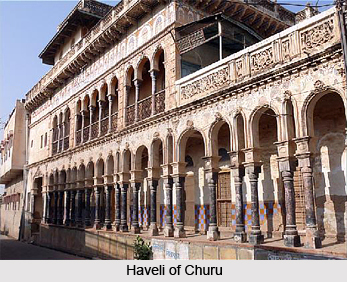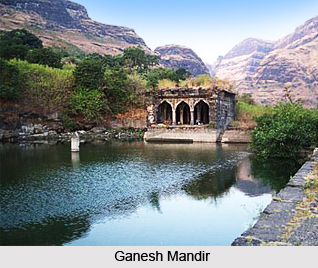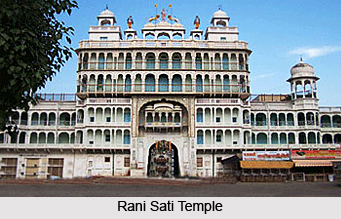 Tourism in Churu District is an enchanting affair as the place is full of antiquity and retains the essence of an era gone by. Beautiful temples, forts, and magnificent havelis rank high among the various places of attraction that Churu district offers to its visitors. The city has a magnificent fort which is believed to have been built by Thakur Khushal Singh in the year 1739 AD. The proud fort stands in the middle of the town where it is said that the brave Thakur Sheoji Singh tried to defend its honour by firing silver canon balls at the attacking army of the Raja of Bikaner. Apart from the many places of historic interest, there is also a wildlife sanctuary for the wildlife enthusiasts. Discussed below are the various place of tourism in the district of Churu.
Tourism in Churu District is an enchanting affair as the place is full of antiquity and retains the essence of an era gone by. Beautiful temples, forts, and magnificent havelis rank high among the various places of attraction that Churu district offers to its visitors. The city has a magnificent fort which is believed to have been built by Thakur Khushal Singh in the year 1739 AD. The proud fort stands in the middle of the town where it is said that the brave Thakur Sheoji Singh tried to defend its honour by firing silver canon balls at the attacking army of the Raja of Bikaner. Apart from the many places of historic interest, there is also a wildlife sanctuary for the wildlife enthusiasts. Discussed below are the various place of tourism in the district of Churu.
The Kothari and Surana Havelis are a group of handsome painted havelis built by two prominent Oswal Jain merchant families, the Kothari and Surana clans. Amongst them are `Malji Ka Kamra` (Malji`s Haveli), an exotic stucco extravagaza built by Malaji Kothari around 1925 and the massive Surana Double Haveli, said to boast 1111 windows and doors built in the 1870s. Just south of the main bazaar, this haveli built around 1880 boasts the finest frieze in the entire Shekhawati region. It illustrates Dhola and Maru on a camel fleeing the wicked Umra-Sumra, Sassi and Punu side by side on horseback, two set of lovers from folk tales. To the south-west is a mosque, Jama Masjid, and a little Muslim haveli decorated with non-figurative work.
 Sethani ka Johara is situated some 3 kms west by the Ratangarh road. It is a beautiful reservoir built by Bhagwan Das Bagla`s widow as a relief project during the terrible `Chhapan Akaal`, the Famine of 1956 Vikram Samvat era (1899AD). The water attracts birds and mammals such as `Nilgai`, a large antelope.
Sethani ka Johara is situated some 3 kms west by the Ratangarh road. It is a beautiful reservoir built by Bhagwan Das Bagla`s widow as a relief project during the terrible `Chhapan Akaal`, the Famine of 1956 Vikram Samvat era (1899AD). The water attracts birds and mammals such as `Nilgai`, a large antelope.
Churu has some good memorial domes, chattris, mostly raised to rich merchants, north of town. Historically the most significant is `Aath Kambh Chhatri` (Eight Pillar Dome) west of the vegetable market. It was built in 1776 on a Rajput`s cremation site. Its base has been virtually buried by windblown sand. The interior is covered with murals, one detail depicting an early European mercenary on foot, bearing a musket. Further north are chhatris of the Mantri , Bagla and Lohia merchant families.
Ratannagar, the mini Jaipur, is said to have been built and developed by Seth Nand Ram Kedia from Bissau, in Vikram Samvat 1917 (1860 A.D.) and named after Bikaner ruler, Raja Ratangingh. The town was developed in a planned manner having wide pathway crossing one another at a 90 degree angle and proper drainage system. At every Chouraha, there is a beautiful circular tree stand. Beautiful gardens and well decorated palatial havelis in a sequential row give a heritage look to the same. The main havelis are: Champalal Sohanlal Hiralal Hirawat haveli, Bilas Rai Arjundas Kedia haveli, Chandi Prasad Kedia haveli, Laxminarayan Chandgothia haveli, Ganga Prasad Chandgothia haveli, Hari Charan, Dwarka Das, Basudev gadodia haveli, Mool Chand Poddar haveli and Jalan haveli. Raghunathji, Laxminarayanji and Chandgothia temples are also decorated with beautiful wall paintings. The paintings in Godia `Chhatri` are worth seeing. The Ratnagar forest adjoining it is home to a great many varieties of animals.
The religious places situated in Ratannagar are Shyam Vatika, Onkar Ashram, Ganesh Mandir, Veer Hanuman temple, Rani Sati temple, Idgah mosque, Jumma mosque, Madina mosque and Dargha Peer Sahib. Other tourist places around the town include Ramgarh, Mahansar, Bissau, Churu and Mandawa, Mukandgarh, Fatehpur, Laxmangarh and Nawalgarh as nearby towns.
 Salasar houses the famous Balaji Temple which attracts a large number of devotees from all over India. Shri Hanumanji, the famous Hindu deity of vigour and loyalty, having been pleased by the devotion and worship of Shri Mohan Das Mahraj, appeared in the form of a statue on Saturday, Shrawan Sukla Navami, Virat Samvat 1811 at Asota village. The statue was brought to Salasar where the temple was built. Later, the devotees added more buildings to the main temple. Two large fairs are held on Chaitra (April) and Ashwin purnimas(October) every year. Lacs of devotees from all over the country and abroad come and offer their wishes to great Lord Hanuman in the temple and have a `Darshan` of Shri Balaji throughout the year.
Salasar houses the famous Balaji Temple which attracts a large number of devotees from all over India. Shri Hanumanji, the famous Hindu deity of vigour and loyalty, having been pleased by the devotion and worship of Shri Mohan Das Mahraj, appeared in the form of a statue on Saturday, Shrawan Sukla Navami, Virat Samvat 1811 at Asota village. The statue was brought to Salasar where the temple was built. Later, the devotees added more buildings to the main temple. Two large fairs are held on Chaitra (April) and Ashwin purnimas(October) every year. Lacs of devotees from all over the country and abroad come and offer their wishes to great Lord Hanuman in the temple and have a `Darshan` of Shri Balaji throughout the year.
Talchhapar Sanctuary is famous for the endangered black-buck. Other wild animals found in the sanctuary are chinkara, fox, jungle cat and rojra along with many resident and migratory birds. It lies along the way of the migratory passage of many birds and therefore it is also popular with bird lovers. Talchhapar, which is actually a flat saline depression, has a unique ecosystem. Talchhapar area was a game reservoir for the erstwhile Maharaja of Bikaner State and was declared a reserved area for the protection of wild animals and birds in the year 1962. Total area of Talchhapar Sanctuary is 719 hectares. The sanctuary area is mostly covered by grass with very few and sparse trees of Khejri, Salvadora, Ber, Ker and Neem tree. Main types of grass found in the area are Sewan, Doob, Dhaman Lampla, Lana and Moth etc. The area has a lush green look during te rainy season but dries up again during the summer season.
Thus discussed above are the various places of tourism in the district of Churu, Rajasthan.



















